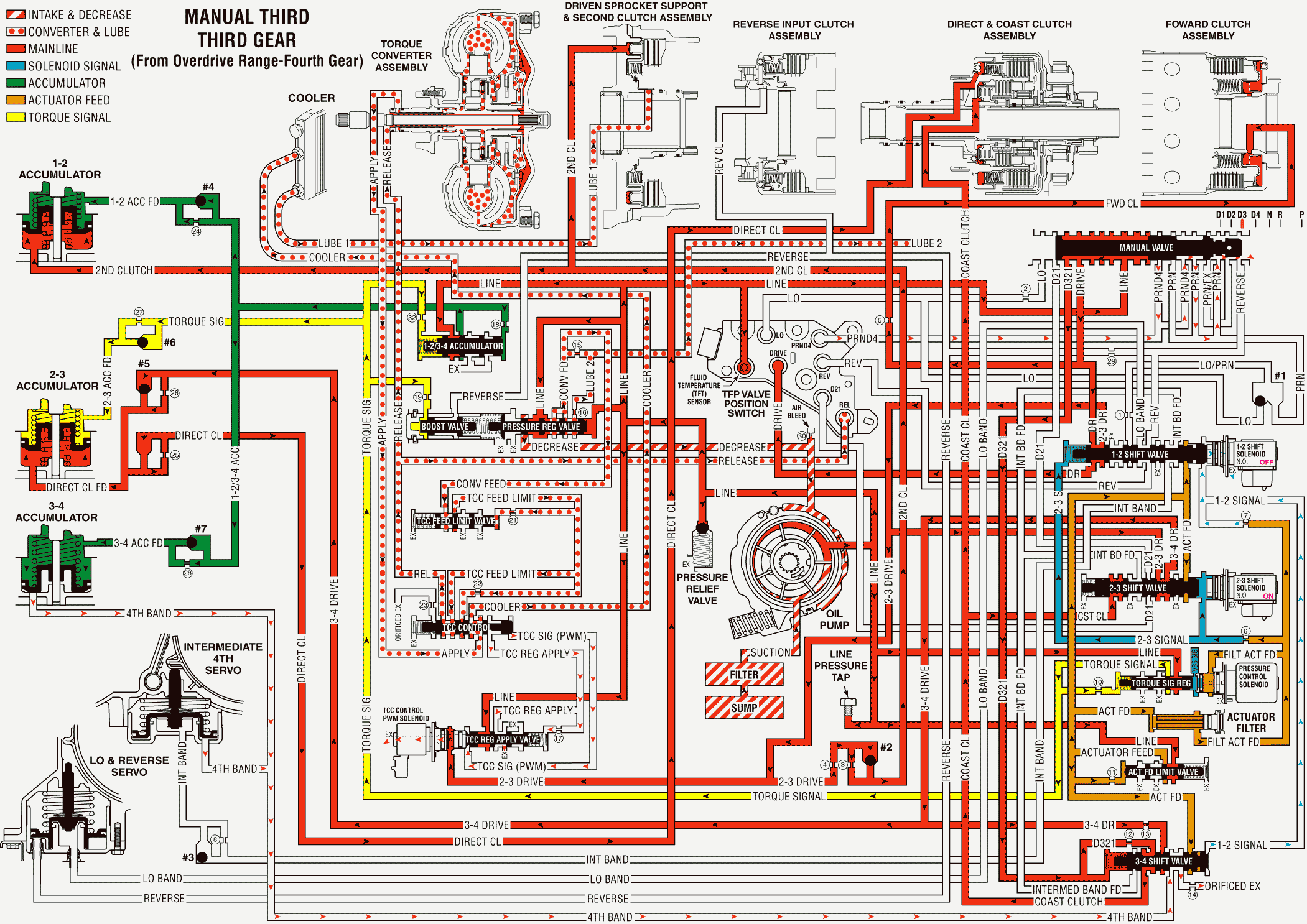Important: The operating states for the shift solenoids follow the normal operation depending on vehicle driving conditions
A manual 4-3 downshift is accomplished by moving the gear selector lever to the Manual Third (3) position. In Manual Third the transmission is hydraulically prevented from upshifting into Fourth gear under any conditions. Also, the coast clutch is applied in all manual ranges in order to provide engine compressing braking whenever appropriated. The following information explains the additional changes during a Manual 4-3 downshift as compared to a forced 4-3 downshift. Refer to Overdrive Range, 4-3 Downshift - Torque Converter Clutch Not Applied for a complete description of a 4-3 downshift.
Fourth Gear Hydraulically Prevented
Manual Valve
The manual valve moves into the Manual Third (3) position and line pressure enters the D321 fluid circuit. Also the manual valve blocks line pressure from the PRND4 fluid circuit and the PRND4 fluid exhausts past the manual valve.
3-4 Shift Valve
D321 fluid pressure assists a spring force in order to keep the valve in the Third gear position under any conditions. this opens the Forth band fluid circuit to an orificed exhaust and the Intermediate and Fourth band releases, thereby preventing Fourth gear.
A/T Fluid Pressure Manual Valve Position Switch (TFP Val. Position Sw.) Assembly
PRND4 fluid exhausts from the TFP Val. Position Sw. Assembly, which signals to the PCM that the manual valve is in the Manual Third position.
Manual Third -- Second and First Gears
The transmission operates the same in Manual Third as in Overdrive range with the exception that Fourth gear is prevented. The transmission will upshift and downshift between First, Second, and Third gears as in Overdrive range. However, engine compression braking is not available in Manual Third - First and Second gears, and the vehicle will coast when you release the throttle.
Drive Range, Manual 3rd (from Overdrive Range)

Drive Range, Manual Third (from Overdrive Range) W/O Electronic Range Select Mode
Important: The operating states for the shift solenoids follow the normal operation depending on vehicle driving conditions
A manual 4-3 downshift is accomplished by moving the gear selector lever to the Manual Third (3) position. In Manual Third the transmission is hydraulically prevented from upshifting into Fourth gear under any conditions. Also, the coast clutch is applied in all manual ranges in order to provide engine compressing braking whenever appropriated. The following information explains the additional changes during a Manual 4-3 downshift as compared to a forced 4-3 downshift. Refer to Overdrive Range, 4-3 Downshift - Torque Converter Clutch Not Applied for a complete description of a 4-3 downshift.
Fourth Gear Hydraulically Prevented
Manual Valve
The manual valve moves into the Manual Third (3) position and line pressure enters the D321 fluid circuit. Also the manual valve blocks line pressure from the PRND4 fluid circuit and the PRND4 fluid exhausts past the manual valve.
3-4 Shift Valve
D321 fluid pressure assists a spring force in order to keep the valve in the Third gear position under any conditions. this opens the Forth band fluid circuit to an orificed exhaust and the Intermediate and Fourth band releases, thereby preventing Fourth gear.
A/T Fluid Pressure Manual Valve Position Switch (TFP Val. Position Sw.) Assembly
PRND4 fluid exhausts from the TFP Val. Position Sw. Assembly, which signals to the PCM that the manual valve is in the Manual Third position.
Manual Third -- Second and First Gears
The transmission operates the same in Manual Third as in Overdrive range with the exception that Fourth gear is prevented. The transmission will upshift and downshift between First, Second, and Third gears as in Overdrive range. However, engine compression braking is not available in Manual Third - First and Second gears, and the vehicle will coast when you release the throttle.
Drive Range, Manual 3rd (from Overdrive Range) - Without Electronic Range Select Mode

